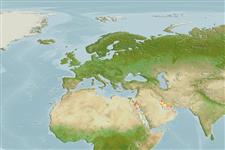>
Gobiesociformes (Clingfishes) >
Gobiesocidae (Clingfishes and singleslits) > Diademichthyinae
Etymology: Lepadichthys: Greek, lepas, -ados = limpet + Greek, ichtys = fish (Ref. 45335); erythraeus: From the Greek for red, in reference to the Mare Erythraeum, an ancient name for Red Sea (Ref. 42101).
More on authors: Briggs & Link.
Environment: milieu / climate zone / depth range / distribution range
นิเวศวิทยา
เกี่ยวกับทะเล,น้ำเค็ม สัตว์น้ำหน้าดิน; ระดับความลึก 1 - 3 m (Ref. 103877). Tropical
Western Indian Ocean: Red Sea, from the Gulf of Aqaba and Gulf of Suez, south to Al Wajh (northeastern Saudi Arabia).
ขนาด / น้ำหนัก / Age
Maturity: Lm ? range ? - ? cm
Max length : 3.7 cm SL เพศผู้/กระเทย; (Ref. 42101)
Short description
สัณฐานวิทยา | ความยาวต่างๆ
เงี่ยงครีบหลัง (รวม): 0; ก้านครีบอ่อนที่หาง (รวม): 15-16; เงี่ยงครีบก้น 0; ก้านครีบอ่อนที่ก้น: 13; สัตว์มีกระดูกสันหลัง: 34. This species is distinguished by the following characters: a membrane joining dorsal and anal fins with the caudal fin; the anus is closer to anal fin than to disc, about two-thirds the distance from the rear margin of the disc to the origin of anal fin; upper attachment of gill membrane opposite ninth pectoral-fin ray; second gill arch with 8 rakers; postdorsal-caudal distance 6.4-7.3 in dorsal-fin length; D 15-16; A 13; pectoral-fin rays 26-28 (rarely 28); principle caudal-fin rays 12; total caudal-fin rays 20 (Ref. 103877).
Specimens were collected from the base of a coral block on a reef flat with mixed sand and flat rock with patches of dead corals, from within live coral head in a sheltered bay, from a fringing reef at a depth of 1-3 m and from an isolated coral block. All were collected in close association with sea urchins of the genus Diadema, utilizing the long spines for shelter (Ref. 103877).
Life cycle and mating behavior
วัยเจริญพันธุ์ | การสืบพันธุ์ | การวางไข่ | เซลสืบพันธ์ของเพศเมีย(ไข่) | ความดกของไข่ | ตัวอ่อน
Oviparous, distinct pairing during breeding (Ref. 205).
McAllister, D.E., 1990. A working list of fishes of the world. Copies available from D.E. McAllister, Canadian Museum of Nature, P.O. Box 3443, Ottawa, Ontario K1P 6P4, Canada. 2661 p. plus 1270 p. Index. (Ref. 27116)
IUCN Red List Status (Ref. 130435)
Threat to humans
Harmless
Human uses
ข้อมูลเพิ่มเติม
ชื่อสามัญชื่อพ้องกลไกการเผาผลาญพลังงานผู้ล่าการศึกษาเกี่ยวกับผลกระทบของสารประกอบทางเคมีที่เป็นอันตรายต่อสิ่งมีชีวิต ประชากร และสิ่งแวดล้อมการสืบพันธุ์วัยเจริญพันธุ์การวางไข่การรวมกลุ่มวางไข่ความดกของไข่เซลสืบพันธ์ของเพศเมีย(ไข่)Egg development
Age/SizeการเจริญเติบโตLength-weightLength-lengthLength-frequenciesความยาวต่างๆสัณฐานวิทยาตัวอ่อนพลวัตของสัตว์น้ำวัยอ่อนการทดแทนที่อุดมสมบรูณ์BRUVS
อ้างอิงการเพาะเลี้ยงสัตว์น้ำประวัติการเพาะเลี้ยงสัตว์น้ำสายพันธุ์พันธุศาสตร์ElectrophoresesอัตราพันธุกรรมโรคการแปรรูปNutrientsMass conversion
ผู้ร่วมมือรูปภาพหลายรูปStamps, Coins Misc.เสียงปลามีพิษ เช่น ปลาปักเป้าความเร็วรูปแบบการว่ายน้ำพื้นที่เหงือกOtolithsสมองวิสัยทัศน์
เครื่องมือ
Special reports
Download XML
แหล่งที่มาจากอินเตอร์เน็ต
Estimates based on models
Preferred temperature (Ref.
123201): 23.5 - 27.7, mean 26.1 °C (based on 72 cells).
Phylogenetic diversity index (Ref.
82804): PD
50 = 0.5005 [Uniqueness, from 0.5 = low to 2.0 = high].
Bayesian length-weight: a=0.00389 (0.00180 - 0.00842), b=3.12 (2.94 - 3.30), in cm total length, based on all LWR estimates for this body shape (Ref.
93245).
ระดับชั้นอาหาร (Ref.
69278): 3.5 ±0.2 se; based on size and trophs of closest relatives
ความสามารถในการกลับคืนสู่ปกติ (Ref.
120179): ความสูง, เวลาต่ำสุดที่จะทำให้ประชากรเพิ่มขึ้นเป็น 2 เท่าใช้เวลาน้อยกว่า 15 เดือน (Preliminary K or Fecundity.).
Fishing Vulnerability (Ref.
59153): Low vulnerability (10 of 100).
